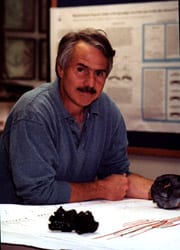Two WHOI Scientists Recognized with Endowed Positions
October 19, 2001
Two scientists have been recognized by the Woods Hole Oceanographic Institution (WHOI) for their contributions to ocean sciences research. Drs. Daniel J. Fornari of the Geology and Geophysics Department and Rui Xin Huang of the Physical Oceanography Department have been named recipients of a W. Van Alan Clark Chair for Excellence in Oceanography at the Institution. Each endowed chair brings financial support for a period of five years, allowing the recipient the freedom to pursue a variety of career interests. The awards were announced today during the Institution’s fall meeting of the Board of Trustees and Members of the Corporation and are effective January 1, 2002.
“These chairs, which are endowed positions for senior scientific staff, allow the Institution to recognize excellence in various fields of marine research by providing support that will encourage further creativity and innovation by some of our best minds,” WHOI Director Robert B. Gagosian said in announcing the awards. “It gives the recipients time to pursue areas of research they may not have been able to do before, to write and to think more deeply about future directions, and to seek and pursue new opportunities. Colleagues will benefit from what they discover, and the Institution will benefit by allowing two of its stars to reach a little higher. They are pushing the envelope, and that means society as a whole will also benefit from what they accomplish.”
Dr. Daniel J. Fornari, recipient of the W. Van Alan Clark, Sr., Chair for Excellence in Oceanography, is both a senior scientist and Chief Scientist for Deep Submergence. A 1972 graduate of the University of Wisconsin-Madison, he received masters’ degrees in geology in 1975 and a doctorate in marine geology from Columbia University in 1978. He joined the WHOI staff in 1993 as an associate scientist in the Geology and Geophysics Department and was also named to the new position of Chief Scientist for Deep Submergence. He was promoted to his current position as a senior scientist in 1998. Fornari has participated in more than 40 major oceanographic research cruises and has published more than 75 scientific papers.
Fornari’s research has focused on understanding the mid-ocean ridge and the relationship between hydrothermal activity, volcanism and tectonism of active areas of the ridge system. His long-term research on the fast-spreading East Pacific Rise has provided the foundation for our understanding of fast spreading ridges worldwide.
A colleague noted in the nomination that Dan “works tirelessly, and his boundless energy is constantly directed toward many different tasks —many of which are to help others. He gives generously of his time, and yet is still incredibly productive scientifically.” Others note his ability to bring a wide range of geophysical, geological and geochemical techniques to bear on a specific scientific problem by leading the development of projects that require collaboration among several investigators with a diverse set of interests.
As Chief Scientist for Deep Submergence at the Institution, he is considered by many as the leading authority on the use of deep submergence vehicles in seafloor exploration. Colleagues note that Fornari has been a “tireless advocate for advancing deep submergence technolog” and for upgrading and improving systems to benefit the scientific users of such tools as the deep-diving, three-person submersible ALVIN and the remotely operated vehicle JASON as well as the operations groups for these and other vehicles. Fornari has also been active in education, co-creating the Institution’s award-winning “Dive and Discove” web site to bring exploration to students and the public through on-line expeditions around the world, the most recent to the Indian Ocean and Galapagos Islands.
Rui Xin Huang, recipient of the W. Van Alan Clark, Jr., Chair for Excellence in Oceanography, was born in China in 1942 and received his bachelor’s degree in fluid mechanics from the University of Science and Technology in 1965. He was a research assistant from 1965 to 1978 in the Institution of Mechanics at Academia Sinica in Beijing, China, teaching himself English and mathematics between 1966 and 1972 during the Cultural Revolution in China. He took part in translating a dictionary of physics in five languages (English, German, French, Russian and Chinese) in 1977 before moving to the United States to pursue graduate studies, during which time he endured long separations from his family. In 1984 he earned a Ph.D. in physical oceanography from the Massachusetts Institute of Technology/Woods Hole Oceanographic Institution Joint Graduate Program in Oceanography and Oceanographic Engineering. After a brief postdoctoral appointment at MIT in 1984, Huang spent two years as a Visiting Scientist in the Geophysical Fluid Dynamics Laboratory at Princeton University before joining the Institution staff as an assistant scientist in 1986. Huang has been promoted several times to his current tenured position as a senior scientist, and has been a guest professor at Qingdao Ocean University in China since 1996. He is the author or coauthor of more than 50 referred scientific publications.
Huang’s research has centered on theories and models of the oceanic circulation with a particular interest in thermocline and thermohaline circulation and their links to climate dynamics. He has solved many of the classical problems in ocean circulation that are crucial to understanding how the oceans control climate, and is working to correct many of the problems that exist in models of the climate system. He is considered a pioneer in the study of the theory of the wind-driven ocean thermocline, the layer separating the upper warmer ocean water from lower colder water. Huang was the first person to take existing, simple layer models of the thermocline and produce a useful, numerical version of the theory adequate to describe a realistic and continuous oceanic thermocline flow. A colleague noted in his nomination that Huang “listens carefully to observationalists, incorporating the new information into his theoretical and numerical models of the ocean … He is pushing ocean modeling ahead at a pace that is faster than most modelers find comfortable.” Others point to “his immense creativity” and “adventurous desire to attack important and difficult problems” in physical oceanography.
The endowed chairs are awarded for a five-year period to tenured members of the Institution’s scientific staff who have “distinguished themselves through extraordinary scientific research and education.” Nominations are solicited from the scientific staff, with selection based on the individual’s record of scientific excellence. The Institution’s Director and Executive Committee of the Board of Trustees approve the awards.
The W. Van Alan Clark Chairs were established in 1986 and are named for the late W. Van Alan Clark, Sr., and W. Van Alan Clark, Jr., longtime friends and supporters of the Institution. W. Van Alan Clark, Sr., was a businessman and philanthropist who served as board chairman of Avon Products, Inc. He was one of the first Woods Hole Oceanographic Institution Associates and served the Institution as a Corporation Member and Honorary Trustee. W. Van Alan Clark, Jr., was President and Chairman of Sippican Corp. of Marion, MA, and a former professor and associate dean at the Massachusetts Institute of Technology. He served the Institution as a Corporation Member, Trustee, Associate and was chairman or a member of several Institution committees. Both he and his father were well-known sailors, with W. Van Alan Clark, Sr., involved in international cruising and racing.


